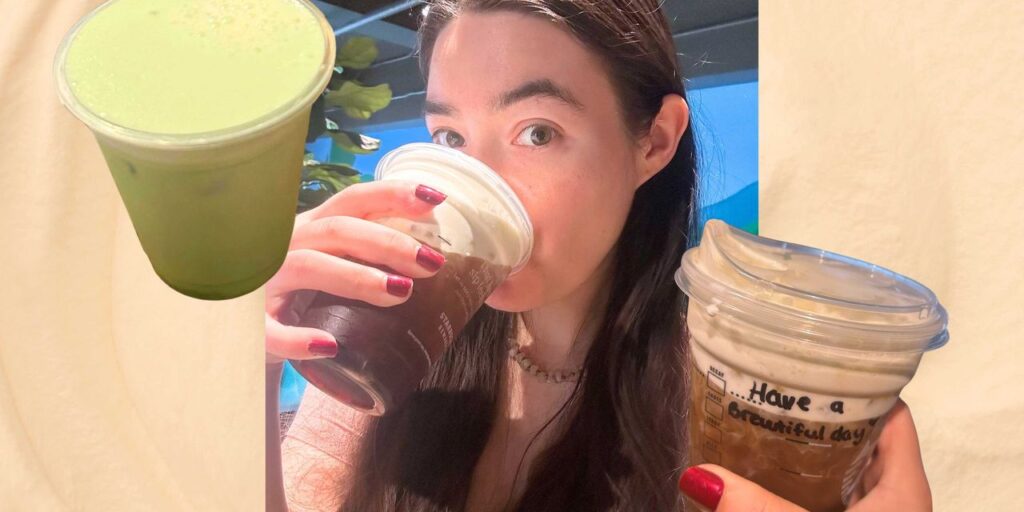As if there weren’t enough protein products on the market already, everyone’s favorite Seattle-based, siren-logo’d coffee chain—Starbucks—is hopping on the bandwagon and debuting several of its own. Following preliminary testing in five stores, protein cold foam and “protein-boosted” milk will be available nationwide in the US and Canada as part of the company’s mission to modernize its menu, according to a September 2 press release (and as a Starbucks representative told me on September 24). Both new products, the rep said, were developed in an effort to respond to consumer trends—namely, the spiking demand for protein-fortified food and drink items.
Hearing this, I wasn’t so sure how the nutritional component would check out. Protein is big right now, sure, but most people actually don’t need any more than they already take in per day, as SELF has previously reported. Nevertheless, when Starbucks offered me a sneak peek in advance of the official rollout, I couldn’t resist. The move “makes a lot of sense” for Starbucks, Federica Amati, PhD, MPH, MSc, a medical scientist who serves as nutrition lead at Imperial College London and chief nutrition scientist at Zoe, tells SELF. Not only does protein “have a massive marketing halo” thanks to online hype, but it’s also inexpensive to add to products—both factors that bode well for a brand’s bottom line. “It’ll be interesting to see how sales go,” Dr. Amati says. In the press release, Starbucks Global Chief Brand Officer Tressie Lieberman framed the menu adjustments as an attempt to “continue to get back to Starbucks.” (In fact, the company announced plans to shutter stores and lay off staff as recently as Thursday.)
With the current trend toward high-protein-everything in mind, I wondered if these new menu additions would do anything more than fuel a fad without much scientific weight behind it. Here’s how it went.
Courtesy of Caroline Tien
Courtesy of Caroline Tien
How does the protein in Starbucks’s new drinks measure up?
So how much protein is in this stuff, exactly? Actually, a significant amount. Protein cold foam—which can be tacked on to any cold coffee, iced tea, or refresher—provides around 15 additional grams of protein per grande-sized beverage (around 50 to 75% of the recommended breakfast protein goal, for context). The foam comes in a “plain” version, as well as chocolate, vanilla, sugar-free vanilla, matcha, brown sugar, and salted caramel; seasonal flavors pumpkin and pecan; and a new addition to the flavor menu, banana.
Meanwhile, the protein-boosted milk adds an extra 12 to 16 grams of protein per grande-sized latte, for reference. The blend of 2% milk and unflavored whey protein powder isn’t available as a creamer for non-dairy drinks (like an Americano or most refreshers) but can be used as a substitute in lattes, cappuccinos, and the like.
In keeping with research showing that customers are willing to pay a premium for high-protein products, adding the cold foam or boosted milk to your order will cost you an extra $2 or $1 respectively (though prices may vary by store), according to Starbucks. Several new beverages will also be joining the store menu as stand-alone offerings, including three protein cold foam drinks—an iced banana cream protein matcha, an iced vanilla cream protein latte, and a chocolate cream protein cold brew—as well as four protein-boosted milk drinks: a sugar-free vanilla protein matcha, a sugar-free vanilla protein latte, a protein matcha, and a vanilla protein matcha, all of which are available either iced or hot.
Here’s my takeaway from the tasting experience.
Starbucks told me that neither the protein cold foam nor the protein-boosted milk have any significant difference in taste or texture compared to the original versions—a claim I was able to verify when the company treated me to a tasting at a New York City store last week. In short order, I sampled an iced sugar-free vanilla protein latte (29 grams of protein per grande); an iced sugar-free vanilla matcha made with protein-boosted milk (36 grams of protein per grande); an unsweetened cold brew topped with plain protein cold foam (17 grams of protein per grande); and an unsweetened matcha latte topped with banana cream protein cold foam (24 grams of protein per grande). Before I left the event, I also picked up two custom beverages to go: a full-sized version of the foamed-up cold brew I’d tried earlier and an iced mocha with chocolate protein cold foam.
All of the drinks received a standing ovation from my taste buds—Starbucks never disappoints in that regard, basic as I may sound. But still, Dr. Amati noted that these menu additions “definitely [reinforce] the message” that people need more protein. “As a general rule, for the adult population, we are not in a place where we need to be worrying about protein intake as long as adequate food consumption is taking place,” she says. What’s more, even if you are among the few demographics (like elderly folks or people on GLP-1s) who would benefit from an additional daily dose, sourcing it from a (likely sweetened) coffee beverage isn’t the ideal route. “For anyone who’s trying to increase their protein intake in a healthy way, this is not what I would recommend doing,” Dr. Amati says. Instead, whole foods are best—lean meat, seafood, cheese, beans, tofu, et cetera.
Which is not to say that the protein foam and the protein-boosted milk are harmful; they’re not. But on the flip side, they may not have any “tangible benefit,” Dr. Amati says—and assuming it doesn’t bring you joy, either, what’s the point? Now, if you want to for your own reasons, more power to you—just don’t feel like it’s necessary (or beneficial) for your health.
Related:
Get more of SELF’s great nutrition content delivered right to your inbox—for free.






